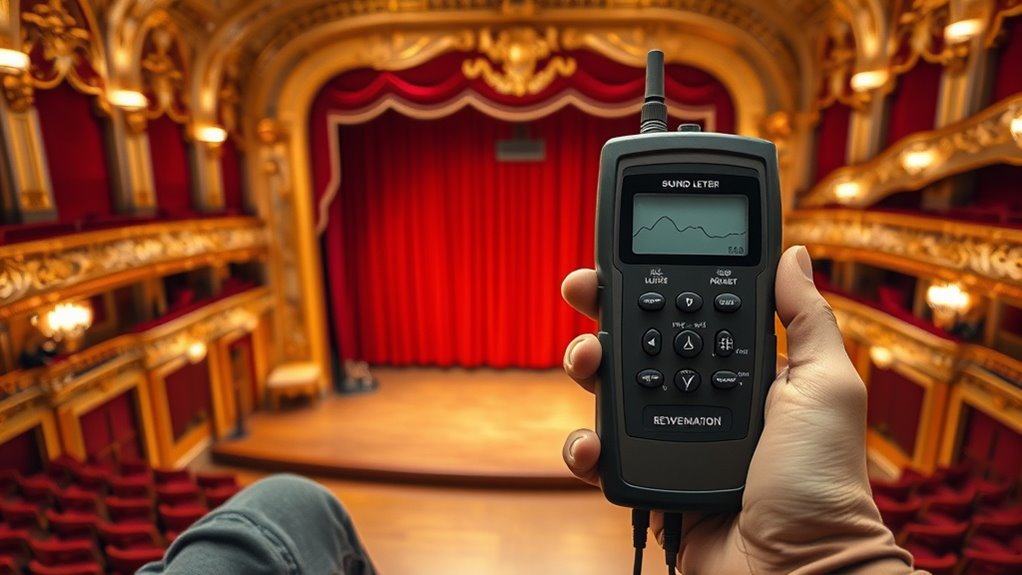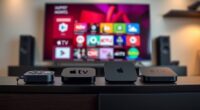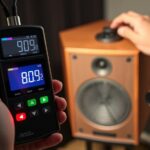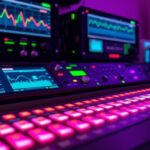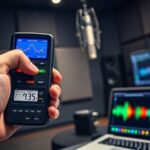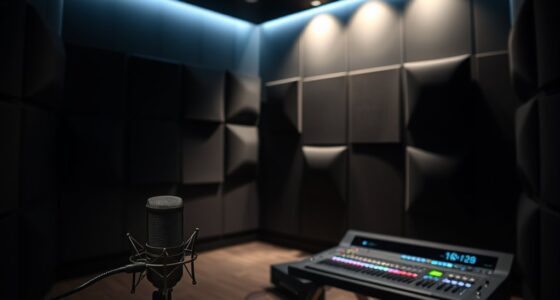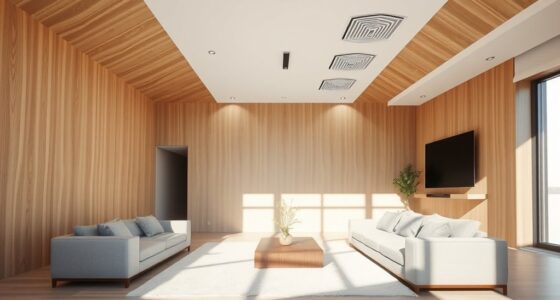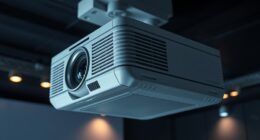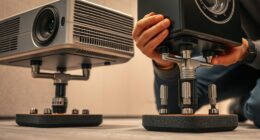To measure reverberation time in your theater, you’ll need a sound level meter and a test sound, like a clap or starter pistol. First, introduce the sound and record how long it takes for the sound to decay by 60 dB. This process shows you how long sound lingers, helping you determine if your acoustics need adjustment. Keep exploring to learn the best methods and tools for precise measurements tailored to your space.
Key Takeaways
- Use a sound level meter or specialized acoustic measurement device to record sound decay after a clap or noise burst.
- Generate a loud, impulsive sound in the theater to initiate the measurement process.
- Measure the time it takes for the sound level to decrease by 60 decibels, indicating reverberation time.
- Conduct multiple tests at different locations to ensure accurate and representative results.
- Analyze the decay data to evaluate if the reverberation time is balanced for optimal acoustic quality.
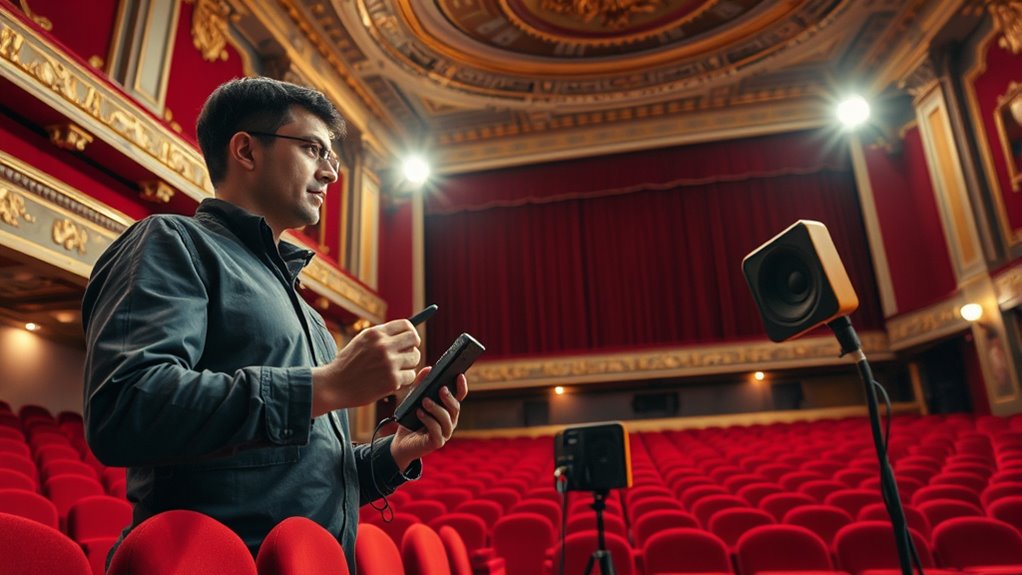
Reverberation time is a essential parameter for understanding how sound behaves in an enclosed space. When you’re working to optimize your theater’s acoustics, knowing the reverberation time helps you achieve the right balance between clarity and warmth in sound. It essentially measures how long sound persists after the source has stopped, giving you insight into how well your space manages sound energy. One of the key factors influencing reverberation time is sound absorption, which involves materials and surfaces that soak up sound waves to reduce reflections. By evaluating the sound absorption qualities of your theater’s walls, ceiling, and seating, you can fine-tune the room’s acoustics to suit your specific needs.
In a theater setting, room acoustics are critical because they directly impact how your audience perceives performances. Too much reverberation can cause sound to become muddy and indistinct, making it difficult for listeners to understand speech or enjoy musical nuances. Conversely, too little reverberation can make the space sound dry and unnaturally dead, stripping away the richness and warmth that audiences expect. As a result, measuring reverberation time isn’t just about quantifying sound decay; it’s about creating an environment where sound feels natural, clear, and immersive. To do this effectively, you need to contemplate the materials used in your theater and how they contribute to sound absorption. For example, adding acoustic panels or curtains can help absorb excess sound energy, lowering reverberation time. Conversely, reflective surfaces like hardwood floors or large glass windows can increase reverberation, which might be desirable in certain musical settings but problematic for speech clarity.
When you measure reverberation time, you gain actionable data that guides your acoustic treatments. You can use specialized tools like a sound level meter or a reverberation time measuring device, which generate a test sound, such as a clap or a starter pistol, and then record how long it takes for the sound to decay by a specific amount. This measurement allows you to evaluate whether your room’s acoustics are balanced or if adjustments are necessary. If the reverberation time is too long, you might add sound-absorbing materials; if it’s too short, you could introduce reflective surfaces or adjust existing ones. Understanding sound absorption is crucial because it directly impacts how sound energy is handled within the space. Ultimately, understanding and controlling reverberation time helps you craft a theater environment where sound is clear, warm, and perfectly suited to your performances. It’s a essential step toward ensuring your audience experiences the best possible acoustics every time they attend.
Frequently Asked Questions
How Often Should I Re-Measure Reverberation Time?
You should re-measure reverberation time whenever you update your acoustic treatment or notice changes in audience density. Regular checks, ideally every 6 to 12 months, help guarantee your theater maintains ideal sound quality. Environmental factors, such as new seating or altered room layouts, can impact acoustics. By staying proactive, you ensure a consistent listening experience, adapting your acoustic treatment as needed to accommodate different audience sizes and configurations.
What Equipment Is Best for Measuring Reverberation Time?
You should use a reliable measurement equipment like a omnidirectional sound source and a calibrated microphone to get accurate reverberation time readings. Guarantee proper calibration techniques are followed, such as using a sound level calibrator before measurements. A digital reverberation time meter or a sound analysis software with a calibrated microphone provides precise results. Regular calibration and proper equipment handling will ensure your measurements stay consistent and accurate over time.
How Does Room Shape Affect Reverberation Time?
Your theater’s shape acts like a sculptor shaping sound waves, influencing reverberation time. In architectural acoustics, a rectangular room might echo endlessly, while irregular shapes scatter sound more evenly. The room’s shape affects sound absorption and reflection, either trapping sound or letting it escape. To achieve ideal acoustics, consider how your room’s form directs sound, balancing reverberation and clarity for a perfect auditory experience.
Can Furniture Placement Influence Reverberation Measurements?
Yes, furniture placement can influence reverberation measurements. The furniture impact depends on the type of acoustic furniture you use; well-placed absorptive pieces can reduce reverberation time by absorbing sound waves. Conversely, hard, reflective furniture may increase reverberation. To get accurate measurements, position acoustic furniture strategically, avoiding clutter and ensuring it doesn’t block sound absorption areas. Proper placement helps you achieve a balanced acoustic environment in your theater.
What Are Typical Reverberation Times for Different Theater Types?
You might think all theaters sound the same, but reverberation times vary widely—typically, 0.8 to 1.2 seconds for concert halls, 1.0 to 1.5 seconds for cinemas, and 0.5 to 0.8 seconds for speech-focused theaters. These times directly impact audience comfort and clarity. Proper acoustic treatment helps you tailor reverberation, ensuring your space sounds just right, whether for music or dialogue.
Conclusion
Just as the maestro fine-tunes each note for perfection, measuring your theater’s reverberation time guarantees every performance resonates flawlessly. By mastering this essential aspect, you shape an acoustic environment where sound dances effortlessly, akin to the harmonious orchestration of a symphony. Remember, like Icarus reaching for the sun, your attention to detail elevates your space beyond ordinary listening—transforming it into a masterpiece where every sound finds its rightful place and clarity.
